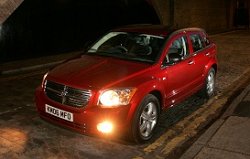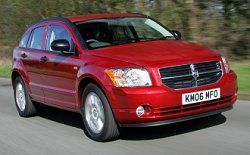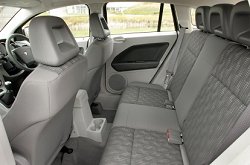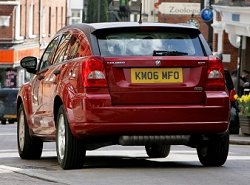The Caliber is Chrysler Group's way of introducing its Dodge brand to the UK market, and it is anything but conventional. The company's intention with this car is to offer a boldly-styled alternative to the relatively bland offerings in the C segment (of which the Ford Focus, Vauxhall Astra and Volkswagen Golf are the leading players) - in fact, the Caliber's outward appearance is one of the two aspects on which Dodge is relying on it to make an impact on customers.

It looks like a crossover between a coupé and an SUV, though it doesn't drive like the former and has none of the off-road capability of the latter. That in itself is quite ironic, since the Caliber shares its platform with the 4x4 Dodge Patriot and Compass models which will arrive on the market in the near future. Anyway, the point is that the Caliber has a stylistic butchness (however unjustified) which, no question about it, is not remotely apparent in the Focus, Astra or Golf.
The other selling point for the car is its low price. You can buy the entry-level 1.8 S for just £11,495 - a remarkable figure considering the Caliber's size. The 2.0 SXT Sport diesel tested here is the Furthest North of the range, and even that comes in at a modest £15,430.
I think Dodge is going about its marketing the right way. The looks - if you like them - and the price structure are the best parts of the range as a whole. The best part of the test car is the engine, which Dodge (as Mitsubishi has done with the Grandis) has bought in from Volkswagen.
There can be no reasonable objection to this. Volkswagen's quiet and smooth-running 138bhp 2.0 TDI unit is one of the best of its type in the world. Despite the Caliber's bulk, it provides combined fuel economy of 46.3mpg along with a very spritely 0-62mph time of 8.8 seconds.
It's so good, in fact, that the rest of the car struggles to keep up. Since UK sales are never going to be very high - "a few thousand" a year, officially - it made no sense to invest much money or effort into re-engineering the Caliber from its US specification.

For conditions on the other side of the Atlantic, its ride and handling may, for all I know, be just peachy, but for our roads they are seriously questionable.
The Caliber is never much fun to drive, and it becomes especially depressing when things get tough. One example of such toughness is the simple matter of pulling out to overtake a slower-moving vehicle ahead. If you combine just a little too much steering input with too much application of the accelerator, you quickly start to feel as if you have a minority vote on the matter of what direction the car will take next.
There is simply too much uncontrolled body lean for the power the Volkswagen TDI engine can provide. Let's hope that's sorted when the 304bhp 2.4-litre turbo SRT4 version comes along next year.
Despite its overall size, the Caliber is also unimpressive in the matter of rear passenger room. At 6'3" tall, I found that my knees and head were rubbing hard against the front seat and roof respectively when I was sitting in the back. The rear seats recline, but they don't slide back and forward, which would have been more useful.

Luggage space is a different matter. With the rear seats up, the Caliber provides 524 litres, rising to 1340 litres when you fold the seats down. These figures could be better (the rear floor is quite high, to provide clearance for the rear axle which both the Patriot and Compass have but the Caliber doesn't) but they're competitive in the C segment all the same.
There has already been press criticism that the interior of the Caliber's interior seems cheap and flimsy. A Chrysler Group spokesman assured me, not without justification, that it's not as low-rent as it appears to be. The plastic is of reasonable quality, but looks worse than it is because the panels it's made of are frequently molded into simple shapes, and they are all coloured a very light shade of grey when a darker tone would be more visually satisfying.
On the other hand, the fact that the interior looks cheaper than it actually is doesn't really help very much. Perceived quality is what's important, and the inside of the Caliber doesn't have a lot of that. Nor is it an especially good thing that the centre of the dashboard comes in the same colour as the exterior. A large chunk of rich metallic paintwork in the middle of so much grey plastic does not do as much to improve the look of the cabin as the Dodge designers perhaps thought it would.

There are some nice touches. The glove compartment has its own air-conditioning vent so you can keep drinks cool in it, there's a neatly-designed torch mounted at the back of the roof, and the vinyl covering over the boot floor can be removed to reveal a washable surface (of that same grey plastic) in case you need to carry something dirty and smelly.
Oh, and in both this model and the very slightly cheaper SXT, the roof-mounted rear audio speakers can be swivelled downwards when the tailgate is open so that you can listen to your fave sounds when you're having a picnic.
This is all rather clever, but it doesn't disguise the fact that the Caliber is not a great car, even if it is distinctly different from anything else on the market. The price and styling are certainly its most important features, and they may also prove to be its saving graces.




